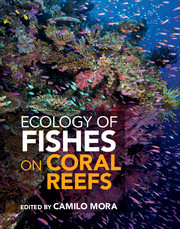Book contents
- Frontmatter
- Contents
- Preface
- Foreword
- List of contributors
- PART I BASIC ECOLOGY
- PART II PATTERNS AND PROCESSES
- 6 The evolution of fishes on coral reefs: fossils, phylogenies, and functions
- 7 Phylogeography of coral reef fishes
- 8 How many coral reef fish species are there? Cryptic diversity and the new molecular taxonomy
- 9 Large-scale patterns and processes in reef fish richness
- 10 Patterns and processes in geographic range size in coral reef fishes
- 11 Patterns and processes in reef fish body size
- 12 Multi-scale patterns and processes in reef fish abundance
- PART III HUMAN FINGERPRINTS
- PART IV CONSERVATION
- PART V DEBATES AND PARADIGM SHIFTS
- References
- Index
11 - Patterns and processes in reef fish body size
from PART II - PATTERNS AND PROCESSES
Published online by Cambridge University Press: 05 May 2015
- Frontmatter
- Contents
- Preface
- Foreword
- List of contributors
- PART I BASIC ECOLOGY
- PART II PATTERNS AND PROCESSES
- 6 The evolution of fishes on coral reefs: fossils, phylogenies, and functions
- 7 Phylogeography of coral reef fishes
- 8 How many coral reef fish species are there? Cryptic diversity and the new molecular taxonomy
- 9 Large-scale patterns and processes in reef fish richness
- 10 Patterns and processes in geographic range size in coral reef fishes
- 11 Patterns and processes in reef fish body size
- 12 Multi-scale patterns and processes in reef fish abundance
- PART III HUMAN FINGERPRINTS
- PART IV CONSERVATION
- PART V DEBATES AND PARADIGM SHIFTS
- References
- Index
Summary
Body size is one of the most important biological characteristics of species. Among reef fishes, size is globally unevenly distributed, species being on average larger in the Atlantic and tropical eastern Pacific (TEP) than in the Indo-Pacific. This is related to species diversity and also probably linked to the history of these regions. Species size is related to numerous biological and ecological characteristics. Here we show the links between size and diet, home range, depth range, and geographical range. The large-scale distribution of species size has important implications at the local level. In particular small species tend to be more abundant than larger ones, which combined with the relationship between species diversity and species size implies higher abundances in species rich zones. Large species being in general more vulnerable to fishing than small ones, this also implies that reef fish assemblages from the Atlantic and TEP will be more vulnerable to a given rate of fishing mortality than those from the Indo-Pacific, all other factors being equal. A conceptual framework on the relationships between species richness, abundance, and biomass is proposed. It shows that the species size distribution within a regional pool, combined with regional and local species richness, may determine in great part the potential response of local assemblages to perturbations.
Body size is a central species parameter in ecology. Ecologists have been looking for general rules linking species' body size to many parameters [27, 36], in particular to geographical distribution [274, 917], temperature (see review by Angilletta [80]), metabolism (see initial theory by Brown [358]), abundance within populations and assemblages at various spatial scales (see review by White [2660]), and vulnerability [e.g. 322, 645, 1873, 1965]. In these domains, there is, however, far more literature on birds and mammals than on fish, and there is at present only a limited amount of work specifically addressing the role of fish body size on coral reefs except the initial review by Munday and Jones [1786] to which most subsequent literature refers.
- Type
- Chapter
- Information
- Ecology of Fishes on Coral Reefs , pp. 104 - 115Publisher: Cambridge University PressPrint publication year: 2015
- 19
- Cited by



